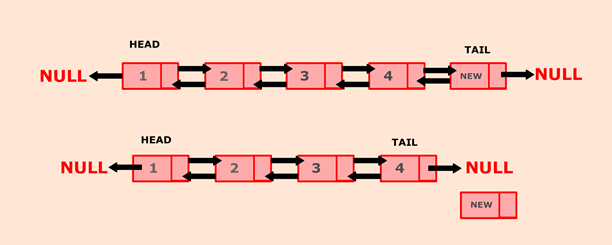Explanation
In this program, we will create a doubly linked list and delete a node from the end of the list. If the list is empty, print the message "List is empty". If the list is not empty, tail's previous node will become the new tail of the list thus, deleting the last node from the list.

In above example, node new was the tail of the list. Make tail's previous node that is, node 4 as the tail of the list. Node 4's next will point to null.
Algorithm
- Define a Node class which represents a node in the list. It will have three properties: data, previous which will point to the previous node and next which will point to the next node.
- Define another class for creating the doubly linked list, and it has two nodes: head and tail. Initially, head and tail will point to null.
- deleteFromEnd() will delete a node from the end of the list:
- It first checks whether the head is null (empty list) then, it will return from the function as there is no node present in the list.
- If the list is not empty, it will check whether the list has only one node.
- If the list has only one node, it will set both head and tail to null.
- If the list has more than one node then, tail's previous node will become the new tail of the list.
- This new tail will point to null thus, delete the last node of the list.
- display() will show all the nodes present in the list.
- Define a new node 'current' that will point to the head.
- Print current.data till current points to null.
- Current will point to the next node in the list in each iteration.
Input:
#Add nodes to the list
dList.addNode(1);
dList.addNode(2);
dList.addNode(3);
dList.addNode(4);
dList.addNode(5);
Output:
Original List: 1 2 3 4 5
Updated List: 1 2 3 4
Updated List: 1 2 3
Updated List: 1 2
Updated List: 1
Updated List: List is empty
Python
Output:
C
Output:
JAVA
Output:
C#
Output:
PHP
Output: